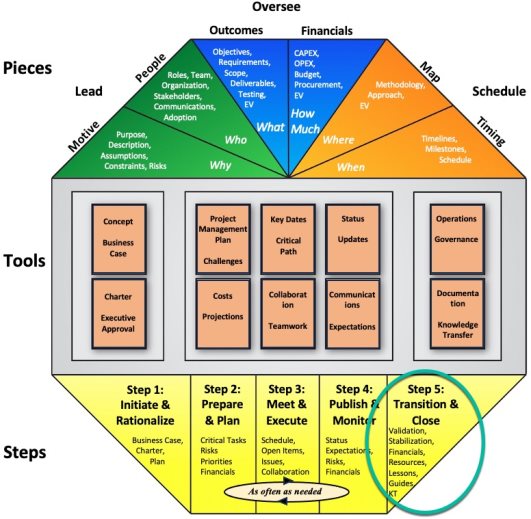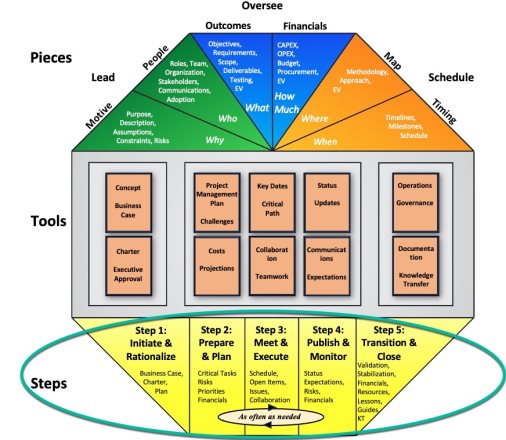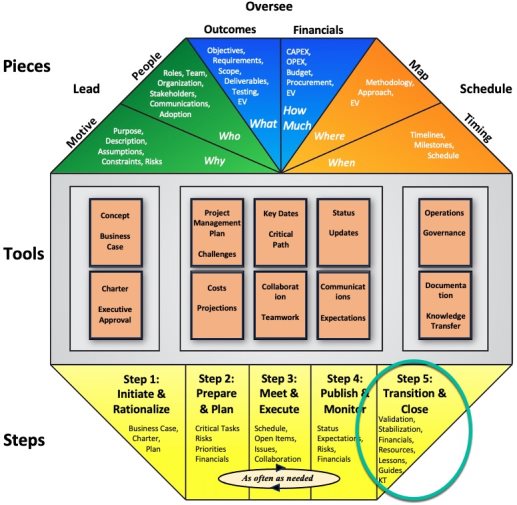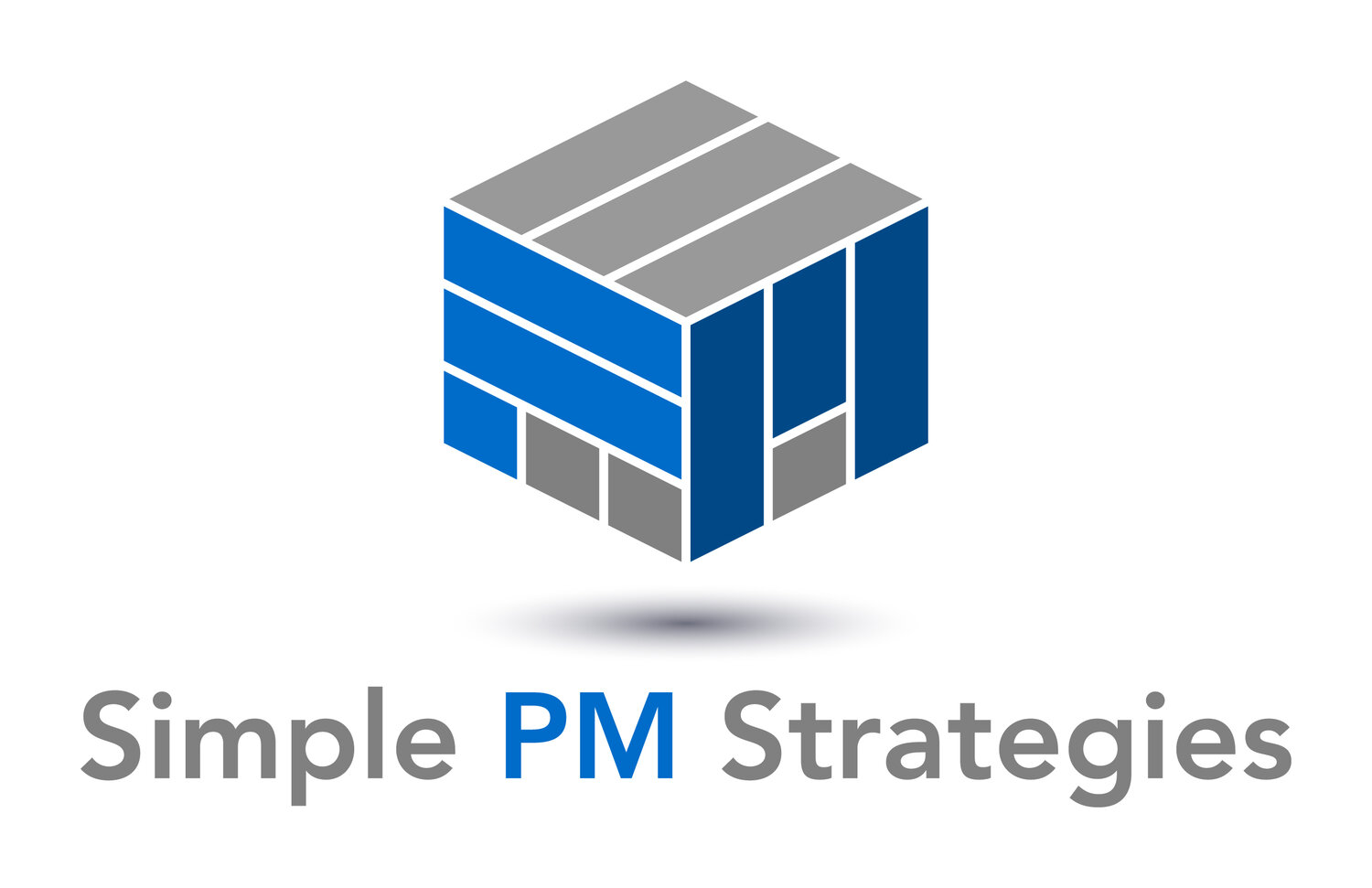How to TRANSITION and CLOSE (Step 5) your Project for Success After the Project
This article covers Step 5 for project success transitioning from a focus on a specific end point to setting the solution up for ongoing, sustained, success.
Step 5 of a project
There are five steps to a project and it’s the fifth step we’re covering here.

Step 5 of project success
Step 5: Transition and Close Concepts
Imagine you had to buy a vehicle and it was like a small project. And you followed the steps to INITIATE your project, to set it up for the greatest probability of success.
Then weekly and daily you followed Step 2 to Prepare and Plan, and Step 3 to Meet and Execute, and Step 4 to Publish and Monitor. If you did them as a habit, you found they didn’t take much time at all, in fact the simple steps saved you time and your little project rolled right along and was done when expected.
Now we need to discuss how you transition from managing in a project mode to managing in an operating mode for the outcomes you created with your project, which is Step 5 Transition and Close.
You completed your vehicle purchase. It was a success, and it was enjoyable and rewarding. You’re having a drink with some delicious appies and thinking, “this was one of the best things I have ever done, thanks to my great project management.”

Celebrate your project success
Your vehicle purchase project was one of the best experiences for your stakeholders too.
Your automotive expert advisor, for example, said they had helped others with their car purchases and the experience with your project to purchase your vehicle was the best they had ever had:
- Communications were excellent and they always felt informed
- The deliverables were well understood, the methodology made sense and the approach and schedule were reasonable
- The project was actually enjoyable, something they looked forward to being a part of during their day and they felt like they were part of a great team.
To review once again, this was all because you set it up for the greatest probability of success.
Then, weekly and daily you followed the small simple habits of success in the other articles.
Now the final step is to transition from a project state to an operational state, so your success continues for what you have created after your project is complete.
The next section is a quick one-page review of the MPM model to refresh the context of where we have been and then we’ll dive into the details of TRANSITION and CLOSE.
MPM Model Quick Review
In our project management MPM model, there are 5 parts:
Step 1: Initiate and Rationalize is noting down key thoughts to ensure you get what you want and you know what “done” looks like before you get started.
Step 2: Prepare and Plan, is a daily or weekly review to ensure strategy and tactics align, or if a change in direction is required.
Step 3: Meet and Execute, is a daily or weekly focus and collaborative brainstorming on what is most critical to get done daily and weekly to stay on track.
Step 4: Publish and Monitor, is a daily, weekly, and even more frequent, process to monitor, assist, and communicate, tasks, outcomes, progress, and challenges.
Step 5: Transition and Close, sets up the outcomes for long term success, and moves resources and activities from a project to operational state.

The project management MPM model has 5 main Steps
Each part of the model always involves all of the other parts as well, but each one of the five labels for that part tells us our intent at that point, indicates what aspect we are emphasizing, and the lens through which we are looking at our project.

Project Management Transition and Close is about Operations Readiness
What is in TRANSITION and CLOSE?
TRANSITION and CLOSE sets up your project outcomes for on-going success.
This article then is about moving any project activities that need to continue after the project is done to someone’s daily or weekly routine, so the project outcomes continue successfully in an operational state.
It is also about leaving behind, but in an organized way, the project resources and details that are no longer active after the project is done but may be needed for reference at some point in the future or may need to be wound down and archived.
Transition is a transfer of responsibilities from the project manager and project team to the daily and weekly routines of someone else in the operational environment.
It may be the same people supporting it operationally as who were supporting it in the project, but the situation has changed, because the allocation of their time, and the priority for use of their time, is now under an operational budget, not a project budget, which appears in a different bucket on the financial accounts and it’s reported differently. Transition then also has financial implications.
Transition involves finding new life and ownership for the parts of the project which need to continue after the project is complete and leaving behind the inactive project-specific activities which no longer need to be performed, but leaving them in an appropriate state.
For example, in a technology project with software, whether it is for a small project or large one, transition involves making sure the activities and steps are in place so software is kept current, that new changes by the software provider continue to work for you and your environment, that on-going training and education is present and updated, and processes are integrated with other aspects of the organization and are managed and kept current.
The danger in skipping the TRANSITION and CLOSE part of your project, is that the outcomes that the project team worked so hard to create and make work may not survive long term in an operational state and may degrade or be deprecated.
There is tremendous inertia to make changes or integrate new things, such as the outcome from projects, into existing work habits and routines even if what you are replacing is manual or clumsy; because the operational world has learned to live with the familiar and is comfortable with it. New ways of doing things and new tools, even though they are more effective and efficient, are hard to adopt because habits are hard to change, and they are personal.
At a very personal level, you know that any change or introduction of something new into an existing set of your routines and habits is a lot of work to make it stick and make the change permanent and successful. A project transitioning to an operational state goes through the same amount of work to make the change permanent and successful, with everyone involved at their own personal level. That’s why this Step 5 is so important.
It is key that your project go through TRANSITION and CLOSE, no matter how trivial outcomes or activities may seem, so that the operational change introduced by the project is supported and continues long term, and change becomes lasting at an organizational and personal level.
Transition items are covered in seven sections: 1. Validation: Stakeholder and Objectives Review, 2. Stabilization, 3. Financial Review, 4. Resource Allocation, 5. Lessons Learned, 6. Guides: Project vs Operational Information. 7. Knowledge Transfer
Each section first explains the project item, then brings in the example of the personal vehicle purchase project to help illustrate the concept of the project

A vehicle purchase is a personal example of a project.
1. Validation: Stakeholder and Objectives Review
This is where you host a review meeting, with your stakeholders, regarding how the project went and how the objectives were met.
The meeting can be held in any number of formats: an informal conversation, an email, in person meeting, or conference call.
Remember we said in the INITIATE and RATIONALIZE step and in STEP 1 PREPARE and PLAN where you make sure you start with measurable objectives and review during your prepare and plan sessions that they continue to meet this criteria? Well, this is where that is tested.

Design for success with measurable objectives
If you know that you are accountable, set yourself up for success earlier on in the project in the INITIATE and RATIONALIZE step when creating your charter, set up your Objectives so they can be independently verified by anyone.
If the project met its objectives
If the project objectives were met the stakeholder validation meeting provides an opportunity to celebrate the project team’s achievements.
It provides closure to the stakeholders, including the sponsor, project manager, and project team to acknowledge the project’s success and the extra efforts of the team to overcome particular project challenges and the value the project outcomes bring to the organization.
If the project didn’t meet its objectives
If the objectives were not met, the project may be closed with items left uncomplete, or it may get more funding to continue to completion of outstanding objectives.
Maybe the stakeholders accept the challenges your project faced and accept that what your project created as “good enough” and consider the project complete. It doesn’t have to be a win-lose situation.
The acknowledgement of what was accomplished, can be a formal document or just the minutes from a stakeholder meeting.
The stakeholder validation review also provides an opportunity for the stakeholders to allocate additional funding if they feel value would be gained by finishing any uncompleted objectives.
The Stakeholder review is the first step in TRANSITION and CLOSE as the stakeholders may increase funding if there are some items remaining that they feel are of value to complete. If that happens then the project is back into the weekly cycle, as before, with STEP 2, 3, and 4 again. It may also require an update to the charter from INITIATE and RATIONALIZE.
The results of the stakeholder validation meetings feed into the Stabilization. The validation is essentially a go-nogo declaration. Once the stakeholders believe the outcomes are ready to go-live then the project proceeds through the three periods of stabilization.
Operational State for Stakeholder Review and Validation for Your Vehicle Purchase Project
In your vehicle purchase project example, here are some examples of outcomes from a stakeholder objectives validation review:
- The vehicle expert, as a stakeholder, identifies that all of the objectives were met; the vehicle was purchased within the time required, the financing met the financial targets, and the vehicle met all of the mandatory requirements for the purchaser.
- The vehicle expert, as a stakeholder, identifies that most of the objectives were met; the vehicle was purchased within the time required, and it satisfied the mandatory requirements, however the monthly financial payments were $50 higher than set out in the objectives. In this case since you were the customer as well, your approval was coincidental, but in a business project, that approval may not be so simple.
Operational State for Stakeholder and Objectives Review and Validation for Projects in General
If the project objectives were not completed but the stakeholder review provided increased funding to complete any remaining unfinished deliverables, then the project enters back into an active state. The appropriate project items are updated and the project once again enters the weekly Step 2, Step 3, and Step 4 cycle and it is not in an operational state.
The stakeholder review can also be advice on how to continue in an operational state with what the project has accomplished and the operational dollars available and then the project continues through the TRANSITION project items.
2. Stabilization
Stabilization is the transition of responsibilities to ensure the ongoing integrity of the outcomes, from the project team to the operations team. Sometimes they are the same team, often not, but even so, the process of stabilization goes through three main periods.
The first period takes place after the outcomes have been validated and the project team is preparing for handoff. During this period they are educating the operations team about the how to support the system. They are also going through a triage of sorts where if issues are discovered they are prioritized to determine if the resolution is absolutely necessary, because during this period the focus is on the plan for go-live so ideally there are no changes or updates to the outcomes as that can require modifications in the go-live plan and cause uncertain delays in go-live.
The second period starts once the project outcomes go-live and continues until the outcomes are stable after go-live which can be days, weeks, or longer. During this period the project team holds the primary responsibility for ensuring the outcomes are working as expected, with the eventual operations team in a secondary support role. This is often called a hyper-care period, because there is a hyper focus on fixing any problems that arise that can negatively impact the outcomes from operating as expected.
The third period starts once the outcomes are considered stable and most of the activity to support the outcomes are now maintenance related and not in support of ensuring the product is operating as expected. Here the operations team is in the primary support role, and the project team is in a secondary support role. This period can last for days, weeks, or longer; as long as it takes until the operations team feels confident that they can handle the solution without help from the project team.
A whole book could be written on how to handle stabilization. The key thing to remember is that it is a handoff of responsibilities to ensure the outcomes are working as expected and it generally proceeds through three periods as the handoff takes place between the project team and the operations team.
Operational State for Stabilization for Your Vehicle Purchase Project
In your vehicle purchase project example, here are some examples of stabilization:
- The first period occurs when you arrange a date and time when ownership is to change hands, and for that exercise it requires you obtain certain specific details from the current owner such as VIN number, current mileage on the odometer, and exact selling price.
- The second period occurs when you are obtaining insurance and registration and the current owner is in parallel, readying the vehicle for handoff to you. Maybe there were some conditions of sale that were required such as a scratch buffed out, or the vehicle washed, or something you noticed fixed. Also if your insurance company of the process of registration requires you circle back to the current owner for additional details, they are still the owner and have full responsibility for handling the vehicle asset and all of its details.
- The third period occurs when you are physically taking ownership, getting the keys, obtaining last minute tips or instructions, and such things as the details about warrantee or whatever after sale care is provided. However this also includes the period as you first begin driving and for some weeks after you begin driving where you may have immediate questions for the previous owner. You are now the primary, but you may be contacting the previous owner to ask questions about something you don’t understand or you need clarification on.
Operational State for Stabilization for Projects in General
The first period of stabilization always starts prior to go-live or handoff. Outcomes are being readied for go-live. During this period outcomes and how they need to work and be handled are being looked at through an operational lens. In other words, from an operational perspective what has to be in place for the outcomes to continue to operate as expected? What resources, processes, steps, financials, management, and so on need to be there so everything continues to work as expected now.
The second period is after go-live and the attention is on keeping the outcomes working as expected now that they are in an operational mode, and adapting and updating any processes and steps where something might have been missed when designing the operational state during the first period. The project team is taking the lead but the operations team is right there with them ensuring they know what is going on and understanding anything that is changing or being updated.
The third period is where the operations team, as new owners, are in the driver’s seat, in full control, but still relying on the project team, or previous owners of the outcomes, for knowledge or assistance, as needed.
3. Financial Review
A financial review examines how capital (CAPEX) and operational expenses (OPEX) were allocated during the project, and it ensures the correct depreciation procedures were followed for CAPEX.
Also reviewed at this time are financial measures such as projections versus actuals and monthly spend versus deliverable progress and how to manage remaining project financial items.
The financial review is conducted with someone from the financial team and if required summarized results can be provided to the project sponsor.
As an engineer who was not a financial person and did not take an MBA, but depended on accounting courses for entrepreneurs, I found the financial review, in terms of how I reported or tracked numbers and presented them to the finance team, was very valuable input to continual learning about how best to track and report financials.
The financial team review should provide any improvements or recommendations in regards to your financial methods or processes for the future.

Conduct a financial review of your budget
Operational State for Financials for Your Vehicle Purchase Project
In your vehicle purchase project, the following financial details may be a part of your review:
- If you have a monthly payment with a lease or loan, are they scheduled to come out of the correct account or does that need to be changed from how it started with the down payment during the project?
- Is there an auto withdrawal set up? If so, do you need to set up a monthly reminder to move the necessary amount from a main account into that bucket at a particular date during the month?
- Maybe you need a reminder to ensure a certain threshold amount in a particular account on a particular day each month?
- Set aside financial amounts in the future in your budget for seasonal tire changes, if applicable.
- Set aside weekly, monthly or semi-annual amounts for items not covered in the warrantee, such as car washes, detailing, or oil changes (if not covered under maintenance).
The above examples may be trivial personal considerations, but they illustrated the need to examine all project outcomes and activities in the operational state and ensure the appropriate funding is available.
Operational State for Financial Review
The sponsor role may need to be involved in the financial review that deals with moving funds to the appropriate operational budget to manage project outcomes and support activities that exist in an operational state.
This also includes moving staff allocations or skill sets that are needed to support the project especially if that operational budget is owned by another manager in the organization.
There may be annual maintenance amounts due in subsequent fiscal periods which also need to be added to some manager’s operational budget. For example, software often has an annual recurring maintenance payment, and one of the management teams needs to own that.
Other financial review considerations for the operational state are any related processes the project depends on that have costs associated with them for an interface created by the project.
4. Resource Allocation
Resource allocation was identified in the Financial Review section, but here allocation refers not to additional expense for staff in the organization, but re-allocating staff whose majority of time was working on the project.
If their time was minor and via a cross-matrix relationship from another business are, as they were on “loan” from that area, then the re-allocation is simpler.

Resource allocation may be necessary after the success of the project
Project resource re-allocation after project completion often requires a conversation with that team member or their manager as they transition back to their functional area.
Non-people resources the project was using need to be allocated to someone else’s area to manage, once the project is complete. For example, machines or equipment that were borrowed or on loan from another business area; or if new equipment or software was purchased, someone needs to own or maintain the operations of that.
As a manager in the project management role, you may have been wearing other hats such as a business analyst or vendor interface, or on-going user training for existing or new staff, and now all of those responsibilities need to be handed off to someone else.
If you were wearing multiple hats, this is now where you face some challenges, handing off those jobs to someone to integrate into their daily and weekly habits.
Oh yes, been there, done that, got the t-shirt. As a manager doing project management on the side, I have worn too many hats and then it takes a lot of work to hand that off to others post-project to make sure someone takes that on, so the ball doesn’t get dropped for each responsibility.
Resource allocation can be very political – usually people have more to do than the time available, so they may resent having to take on yet more responsibilities, so this may be something that needs some discussion ahead of time, long before it is needed at the end of the project.
Resource allocation also includes understanding the difference between the four levels of support: incident management, problem management, change management, and asset management, but that is covered in a future blog post.
Operational State for Resource Allocation for Your Vehicle Purchase Project
In your vehicle purchase project example, here are some examples of allocation of resources:
- Road-side assistance agreements need to be updated with the vehicle make, model and year
- Assigned parking services, including parking tag listings need to be updated with the new vehicle information
Since the project was small re-allocation of resources who were committed on the project is not really an issue. The resource allocation becomes a matter of aligning the new asset, or vehicle, with the various vehicle service arrangements.
Operational state for Resource Allocation for Projects in General
Operational support roles for the project are those that currently exist and need to continue after the project is complete, as well as new roles that may need to be added for the start of operational support.
Operational Support roles have tasks that need to be detailed and an expected average effort per week or year or whatever period is applicable has to be identified. Some of that planning is covered in this blog post.
Operational support roles include all those required to support the solution for incident management (including Tier 1, 2, and 3), change management, problem management and asset management. They need to be listed with the tasks required, time periods and hours required. Those four are covered in this blog post.
Tiered support (1, 2, 3, 4) is explained in this blog post.
As a TRANSITIONAL responsibility the manager of the project works with management teams and support teams to ensure all identified operational support roles and resources are appropriately assigned to ensure successful support of the project solution in an operational state.

TRANSITION ensures all required operational support roles are assigned
5. Lessons Learned
Lessons learned can be collected as the project proceeds, but usually at a “lessons learned” meeting is where they coalesce into a single document.
The lessons learned usually starts with a meeting with the project team where lessons learned items are explored in detail.
The lessons learned exercise then expands to your sponsor, with a summary list that contains less detail and descriptions of recommendations written at a higher level.
Lastly it can be a presentation to executive or stakeholders.
The project manager confers with the sponsor to determine when to hold the meetings and who to include.

Lessons learned can be shared over several meetings with the project team, sponsor, and stakeholders.
Details about how to conduct lessons learned is covered in this blog post, along with a template and example, and in the workshops.
Lessons learned can be very political, so executive, as in sponsor support, is necessary for some of the wording and distribution.
Lessons learned are an opportunity to create valuable input to adjust and update the methodology for future reference.
Operational State for Lessons Learned for Your Vehicle Purchase Project
In your vehicle purchase project example, here are some examples of lessons learned:
- Lessons learned 1:
- Project Deliverable or Activity: Test Drives
- Project Experience: More than three test drives in one evening were rushed and stressful
- Assessment: Room to Improve
- Lessons Learned Recommendation: Limit to two test drives, and reduce the number of overall test drives to meet the project schedule
- Lessons learned 2:
- Project Deliverable or Activity: Monthly financial payment
- Project Experience: Valuable to do the analysis upfront in terms of what is affordable to set realistic expectations for vehicle options
- Assessment: Keep doing
- Lessons Learned Recommendation: Always critical to examine financial targets as constraints for options early on to save time doing test drives for vehicles that are outside the financing range.
Operational State for Lessons Learned for Projects in General
Lessons learned helps the organization by providing input to improvement in general business processes, in the methodology used, and in how projects are conducted.
Remember I said earlier in the PREPARE and PLAN step that the methodology was fluid and a point in time. Now is when the methodology can be updated with input from the lessons learned.
Lessons learned provides feedback to the manager to improve their skills in managing projects on the side, as projects are an on-going reality in any organization.
Lessons learned provides value to future managers managing projects in the organization by giving them knowledge about how to improve how things are conducted to increase their likelihood of success.
6. Guides: Project vs Operational Information
This is where the manager sorts out the information that was only relevant to the project execution, from the information needed to support the solution operationally and ensures the team that is to support the outcomes has the necessary guides to use for reference and how-to’s to appropriately support the project outcomes in an operational state.
Leave behind information that was only relevant when the project was active, such as status reports, project communications, requirements review, project budget, etc.
Create a repository to handle information that sustains the on-going support of what the project has created, such as vendor information, financial information, user or process guides, tip-sheets or documents (the uniqueness of the solution implementation for your organization), training, detailed background about the various pieces of the solutions, to name some of the areas of information.
Where does the information exist so people can find it when they need it such as in a shared space or learning site. Is mobile access needed?
Operational State for Guides: Project vs Operational Information for Your Vehicle Purchase Project
In your vehicle purchase project, you might have the following project specific information that really isn’t relevant when you transition to an operational state:
- List of dealerships visited
- Schedule for test drives
- Funding options
In your vehicle purchase project, you might have the following project specific information, that is needed in an operational state:
- Financial payment schedule
- Asset information for your accountant
- Warrantee information
- Registration – and renewal periods or reminders
- Insurance – and renewal periods or reminders
- Vehicle user guide or tip-sheets for use
Operational State for Guides: Project vs Operational Information for Projects in General
Information necessary to support the solution long term needs to be moved into a location where anyone who needs it or has responsibility for something operational with the project can easily locate it.
Have ONLY ONE LOCATION for the master information for the support of your solution, not several as this causes confusion and can hamper effective support.
Create a optimum folder structure that works best in operations by getting input on the structure from some of the team members who are in the support role. Your perspective as a project manager may be a little too familiar to create an objective view for someone not as familiar with the solution as yourself.
Guides includes any material to help end users, user support teams, or technical operations teams.
7. Knowledge Transfer
Knowledge transfer involves conducting training sessions to ensure the operations team knows how to use the guides and how to support the outcomes in a steady state.
Knowledge transfer (KT) can take several forms.
One form could be shadowing sessions, where the future operations team “watches over the shoulder” of the project team to see how they are solving problems during the first period of stabilization.
Another form could be one on one technical information sharing sessions around specific detailed technical areas of the project outcomes.
Another more familiar form could be actual formal “classroom-like” training sessions, either virtual or in-person.
Operational State for Knowledge Transfer for Your Vehicle Purchase Project
- In your vehicle purchase project, for KT, you might have one-on-one sessions with whomever sold you the vehicle to understand all the intricacies and nuances of how the vehicle features operate.
- You may also have a session with more technical or mechanical leadership where they walk you through preventative maintenance.
Operational State for KT for Projects in General
Knowledge Transfer for projects involves both self-education, one-on-one, and formal class-like settings.
Effectiveness of the training should be measured such as surveying operations and end-user teams to gauge their readiness to take over the solution based on the KT they have been provided.
If the teams are not. Ready additional KT should be provided to avoid risks of errors during stabilization if incorrect actions are taken to resolve an problems or challenges that arise with the outcomes after go-live when they are in an operational state.
Summary
When the project is done, usually that is just the beginning for the life of what you have created.
TRANSITION and CLOSE involves taking the appropriate steps so that what the project creates continues in a way that ensures its long-term success, and that it becomes integrated successfully into the existing habits and routines within the organization and within the personal daily and weekly steps of people who have to ensure the vision of what it achieves continues.
TRANSITION and CLOSE activities ensure the on-going success of what you and the project team have worked so hard to create.
Action Steps / Apply This Knowledge
- Go through each of the sections above for a project you completed recently and put one or two sentences regarding the status of each section.
- If there are any sections that you feel need additional work to ensure the health of what you have created, document that and set up whatever communications or meetings you need to make sure the transition happens as it needs to.
- Look at a current project you have and start a new document, title it with the name of the project and add “Transition” to the title. Add each of the seven transition areas as its own heading and then add one or more sentences under each about what you would like to have as your ideal transition state. This is kind of like beginning with the end in mind and it can alert you to things you should be doing now so that the transition is smoother when your project is complete.
- GPT (e.g. chatGPT) prompt engineering suggestion: “As a manager leading a project whose outcomes include x and y, what transition and close activities should I be considering as my project moves from a project state to an operational state?”
Learn More to Do More
Quick access to steps that help: https://simplepmstrategies.com/learning-hub-index
TRANSITION – Main – Step 5
© Simple PM Strategies 2024
